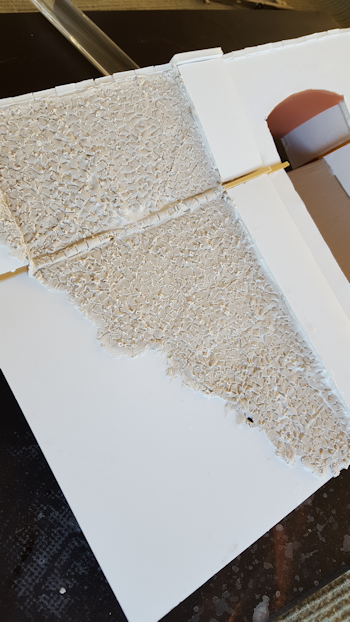I really liked the effect I achieved on the Bolt Tor tunnel portal.
This was done by rolling air-curing clay very thinly, breaking it up into scale sized “stones” and individually gluing them onto the structure of the walls.
However, this was pretty labour intensive and I wasn’t enthralled by the thought of sticking thousands of individual stones over possibly hundreds of square inches.
So I’ve gone for another method to represent the masonry on the reservoir barrier. Rolling the clay really thin – around a millimetre – and glueing the sheets onto the structure, then inscribing the stones while the clay is still plastic.For my first test I glued the clay directly onto a piece of foam board. This resulted in the board warping as it dried. It seems the board I’m using is faced with a card veneer which absorbs water and deforms as it dries out.
I solved this by adding some extra bracing to the rear of any large flat area and sealing the card with an acrylic spray. This seems to work really well. The PVA glue I’m using still fixes the clay to the board.
I’m learning this as I go along, so I’ve had a couple of issues, the most serious being shrinkage of the clay layer causing a couple of cracks large enough to be embarrassing on a representation of a dam. This, as I found out, can be avoided by feathering the joints between adjacent pieces of clay.
I’ll need to go back over a couple bits of the model to eliminate the cracks when it’s all completely dry.
The “stones” were scribed by hand and a pointed piece of wood while the clay was still plastic. This leaves a fair amount of whiskery material sticking out of the wall, but this will be sanded back. So far it looks pretty good.I found the most effective way of marking the random stone was to treat most blocks as irregular pentagons, filling in with rectangular and triangular blocks as appropriate. At the present rate, the rendering is going to take about three to four hours in total.



